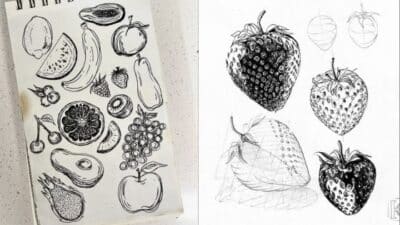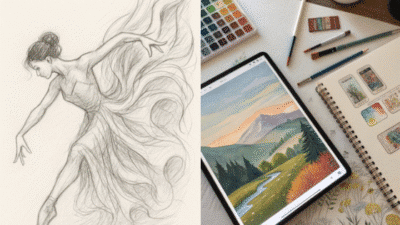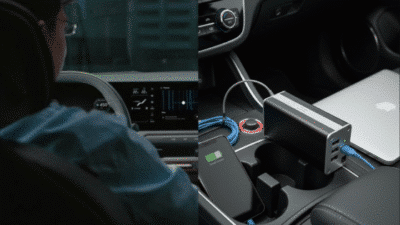Ever found yourself staring at a blank canvas or screen, ready to bring a character to life, only to pause at the hair? It’s a common hurdle for many artists, but mastering it can unlock incredible expressive power in your creations. And when it comes to hairstyles that burst with energy, personality, and dynamic flair, the ponytail reigns supreme! It’s not just a simple pulled-back look; it’s a versatile, vibrant element that can transform a static drawing into a captivating narrative.
Imagine a swift warrior, hair whipping behind them in a high ponytail, conveying speed and determination. Or a dreamy academic, a low, loose ponytail hinting at quiet contemplation. Ponytails are more than just hair; they are storytellers. They can be sleek and sophisticated, wild and free, playfully bouncy, or intensely focused. They communicate movement, personality, and even the character’s current mood. This isn’t just about drawing strands; it’s about infusing life into your art!
Get ready to ditch those stiff, lifeless hair blobs! In this ultimate guide, we’re going to dive deep into the thrilling world of drawing awesome ponytails. We’ll explore the secrets to creating volume, understanding gravity, conveying movement, and nailing those intricate textures that make hair look truly alive. Whether you’re aiming for a sleek anime aesthetic or a grounded realistic style, you’re about to gain the skills to make your characters’ ponytails rock! Let’s embark on this artistic adventure together and transform your hair drawing game forever!
Why Ponytails Are More Than Just Hair
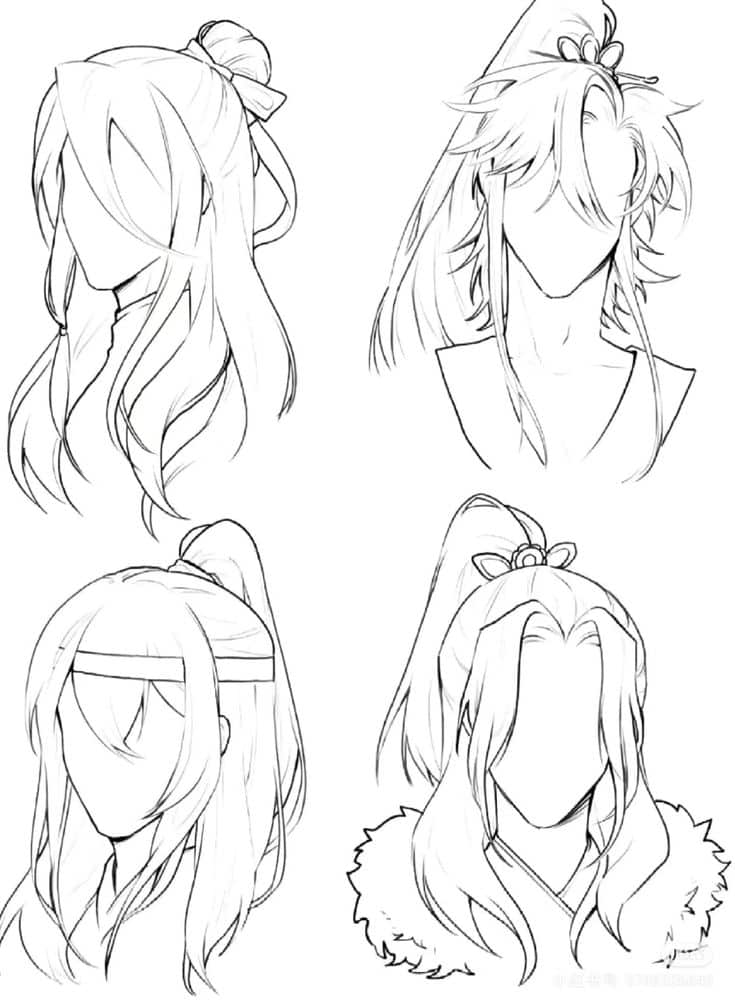
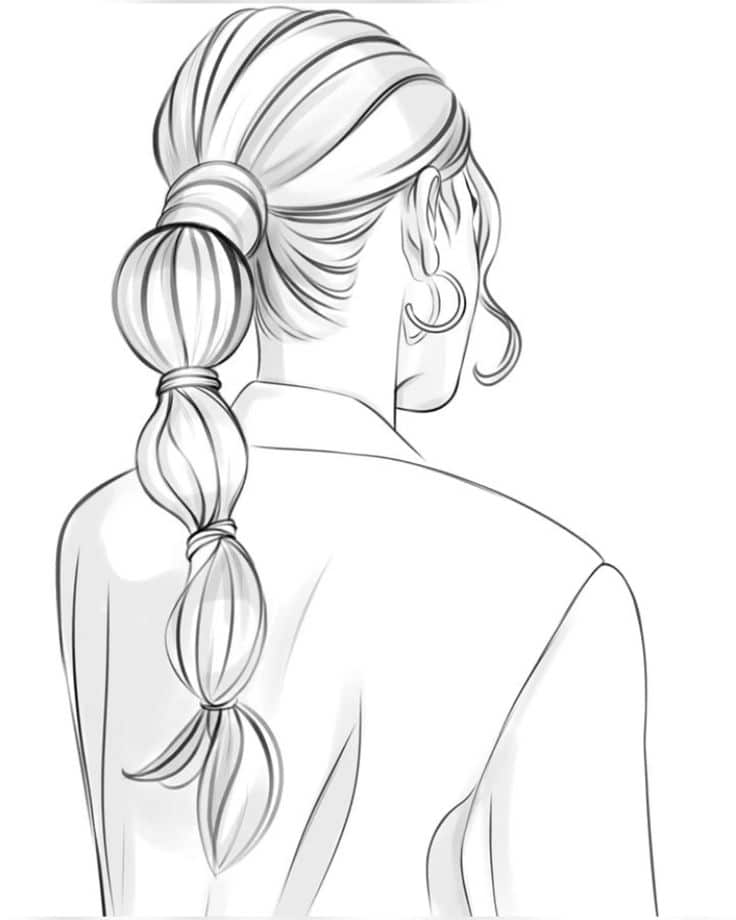
Ponytails might seem simple, but their impact on a character’s overall design and storytelling potential is enormous. They are an often-underestimated tool in an artist’s arsenal, capable of adding layers of depth and dynamism.
First off, expression and personality. A high, tight ponytail can signal readiness, athleticism, or a no-nonsense attitude. A loose, messy one might speak of creativity, carefree spirit, or someone caught in a whirlwind of activity. Think about the subtle messages a hairstyle sends in real life; these translate directly into your art! Your character’s ponytail can instantly communicate their job, their mood, or their inherent nature.
Secondly, dynamic movement. Unlike short hair or elaborate up-dos, ponytails are inherently dynamic. They react to gravity, wind, and the character’s actions with immediate, flowing movement. This makes them fantastic for illustrating motion, energy, and the forces at play in your scene. A character running, jumping, or even just turning their head will cause their ponytail to react, adding a layer of realism and excitement that static hair simply can’t provide. Learning to draw this movement makes your art feel alive.
Finally, versatility. From sleek and polished to wildly disheveled, from a tiny nub to a cascade of curls, ponytails offer an incredible range of styles. This versatility means you can adapt them to any character, genre, or mood. They can be the focal point of a character design or a subtle accent that enhances the overall look. Their adaptability makes them a fundamental skill worth mastering for any aspiring artist.
The Foundation: Understanding General Hair Principles

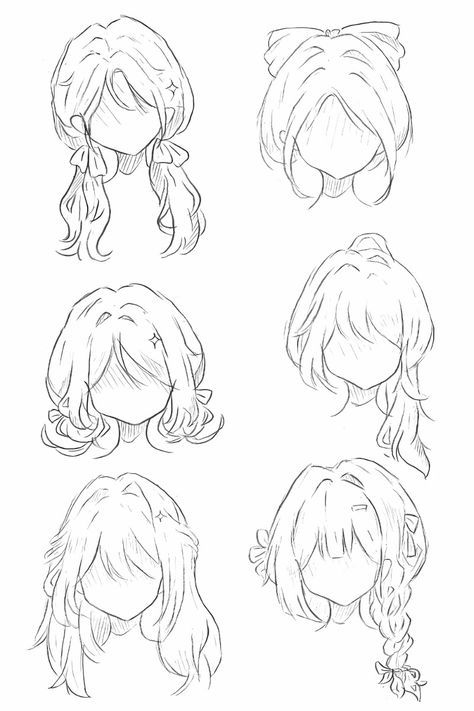
Before we specifically tackle ponytails, let’s quickly revisit some core principles of drawing hair in general. These fundamentals are the building blocks upon which all great hair art is constructed. If you want to know how to draw hair effectively, you have to grasp these basics!
- Think in Shapes, Not Strands (Initially): When you start drawing hair, resist the urge to draw individual strands immediately. Instead, block out the overall shape, volume, and direction of the hair as if it were a solid mass. This “mass” approach helps you establish the correct proportions, flow, and silhouette before getting lost in detail. Think of it as sculpting the hair.
- Gravity is Your Best Friend (and Foe): Hair, like everything else, is affected by gravity. It falls, it hangs, it drapes. Understand how gravity pulls hair downwards, creating natural curves and bends. However, also note how volume and hair texture can defy gravity to some extent, especially at the roots.
- Volume is Key: Flat, plastered-down hair rarely looks natural or appealing. Hair has body and lift. Consider where the hair originates from the scalp and how it puffs out before gravity takes over. The crown of the head often has the most volume.
- Flow and Direction: Hair flows. It moves in a continuous direction, often in S-curves or waves. Identify the main direction of the hair, how it separates into larger clumps, and how these clumps interact. This creates a sense of natural movement and realism.
- Light and Shadow: Hair isn’t just a uniform color. It has highlights where light hits it directly and shadows where it recedes or where strands overlap. These variations in tone are crucial for giving hair dimension and making it look shiny or soft.
- Texture: Is the hair straight, wavy, curly, coily? Each texture behaves differently. Straight hair falls in smooth sheets, while curly hair forms distinct spirals. Understanding different hair textures allows you to draw them convincingly.
By keeping these general principles in mind, you’ll find that drawing any hairstyle, including the mighty ponytail, becomes a much more intuitive and successful endeavor. For more comprehensive insights into drawing hair in various styles, you might find this guide on how to draw hair incredibly useful!
Deconstructing the Ponytail: Core Components
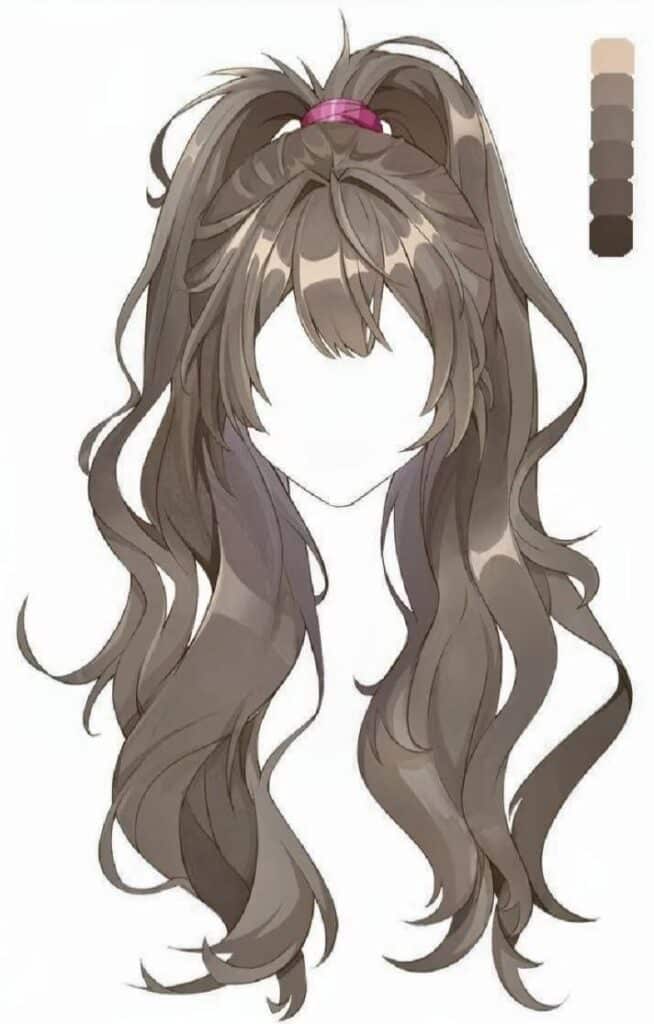
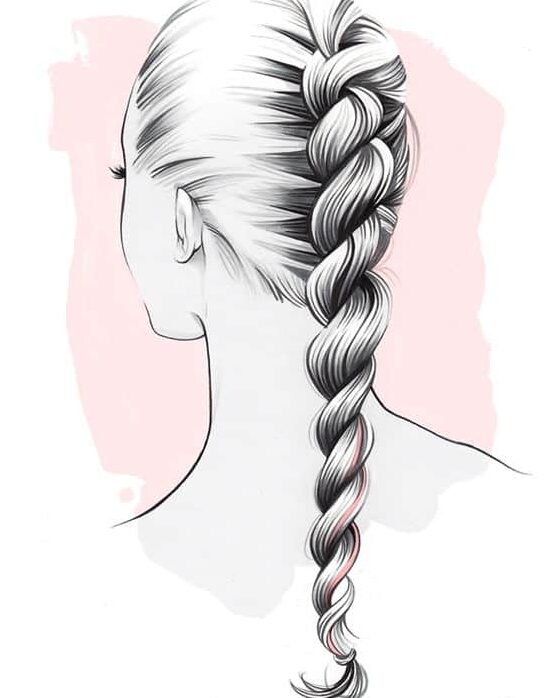
To draw a truly convincing ponytail, it helps to break it down into its fundamental parts. Thinking about these components separately allows you to build a cohesive and dynamic whole.
The Base and Tie: The Anchor Point
This is where the magic begins! The “base” is the section of hair gathered against the head, and the “tie” is the band or accessory holding it.
- Placement Matters: A high ponytail sits on the crown or upper back of the head, giving an energetic, bouncy look. A low ponytail rests at the nape of the neck, often conveying sophistication or a more relaxed vibe. A side ponytail offers a playful or youthful feel. The placement instantly sets a mood.
- The Snugness Factor: How tightly is the hair pulled? A tight, sleek ponytail will show tension around the scalp, pulling the skin slightly. A loose, relaxed one will have more slack and natural bumps.
- Visible Tie vs. Hair-Wrapped: Decide if you want the hair tie (like an elastic band) to be visible or if the character has wrapped a section of their own hair around it for a more polished look. This seemingly small detail adds to the overall aesthetic.
The Main Body of Hair: Volume and Flow
This is the largest and most prominent part of the ponytail, and where gravity and movement truly come into play.
- Initial Mass: Start by sketching a large, flowing shape that represents the entire mass of the ponytail. Don’t worry about individual strands yet. Think about its overall volume, direction, and how it flows away from the head.
- Gravity’s Pull: Even a high ponytail will eventually succumb to gravity, arching downwards. Observe how hair naturally forms a curve. The higher the ponytail, the more initial “lift” it will have before it starts to fall.
- Directional Flow: How is the character moving? Is the wind blowing? The ponytail will follow these forces. Imagine invisible lines guiding the flow of the hair, ensuring it moves coherently.
- Clumping: Hair rarely falls in one perfectly smooth sheet. It tends to separate into larger, more manageable clumps or sections. These clumps create interesting shadows and highlights, adding depth.
Loose Strands and Flyaways: Adding Realism
These are the delightful details that make hair look less like a solid object and more like, well, hair!
- Around the Face: Hair often escapes around the temples, ears, or nape of the neck. These wisps add softness and realism, especially if the character has a lot of layers or movement.
- Within the Ponytail: A few individual strands can escape from the main body of the ponytail, particularly if it’s messy or in motion. This prevents the ponytail from looking too rigid or cartoonish (unless that’s your specific style!).
- Reacting to Environment: If your character is caught in a breeze, those loose strands will be the first to flutter, adding an immediate sense of atmosphere.
By breaking down the ponytail into these manageable components, you can approach your drawing with a clearer strategy, building from the anchor point to the dynamic details.
Volume and Weight: Giving Your Ponytail Body
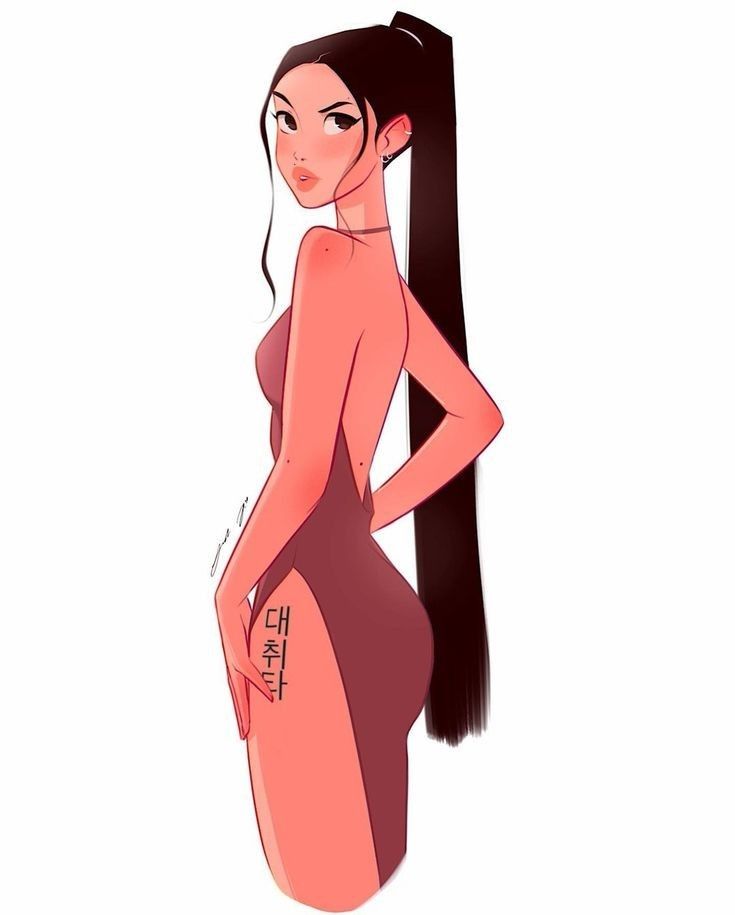
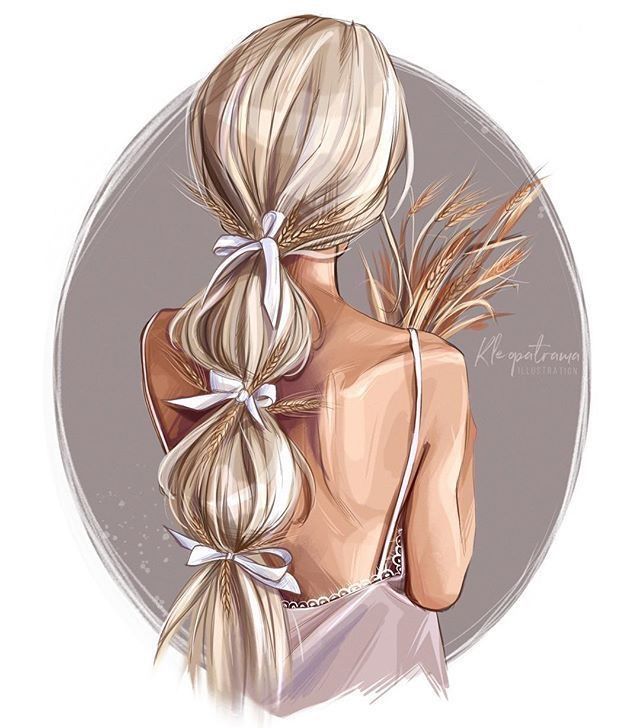
Nothing deflates a drawing faster than flat, lifeless hair. Your ponytail needs volume and a sense of weight to look realistic and appealing. It’s about creating the illusion of three-dimensional form.
Root Lift and Airiness
Even hair pulled into a ponytail doesn’t sit perfectly flat against the scalp. There’s always some natural lift at the roots.
- Start at the Scalp: Imagine the hair growing out from the scalp. It doesn’t immediately fall. There’s a slight outward curve, an initial “poof” of volume before gravity really takes hold.
- Curved Contours: When drawing the hair leading up to the ponytail tie, use subtle curved lines rather than straight ones. These curves indicate the hair lifting away from the head, creating that essential airiness.
- Negative Space: Pay attention to the negative space around the head where the hair might lift away. This separation adds to the sense of volume.
Clumping for Dimension
Instead of drawing hundreds of individual hairs, group them into larger, manageable clumps or sections. This is the secret to conveying volume and light interaction effectively.
- Large, Medium, Small: Think in terms of hierarchical clumps. Start with the largest, overarching forms of the ponytail. Then, subdivide these into medium-sized clumps, and finally, add smaller, more detailed clumps or strands.
- Overlapping and Intertwining: These clumps aren’t flat; they overlap, twist, and turn around each other. This creates natural shadows in the crevices and highlights on the protruding surfaces, giving the illusion of depth and form.
- Directional Flow within Clumps: Even within a clump, the hair will have a consistent flow. Guide your lines along these flows to reinforce the sense of volume and movement.
Conveying Weight
The type of hair you’re drawing impacts how you convey its weight.
- Thick, Heavy Hair: Will fall more directly and have fewer, slower curves. The overall mass will appear denser. The ends might seem heavier and more blunt.
- Fine, Light Hair: Will be more susceptible to air, creating more numerous and tighter curves. It might appear fluffier or bouncier. Individual strands will be more noticeable.
- Length and Weight: Longer ponytails naturally appear heavier and have a more pronounced downward curve due to gravity. Shorter ponytails might stick out more before curving.
By consciously building up volume through root lift and strategic clumping, and by considering the natural weight of the hair, your ponytails will gain a wonderful sense of body and realism.
Texture and Strands: Adding Detail and Realism
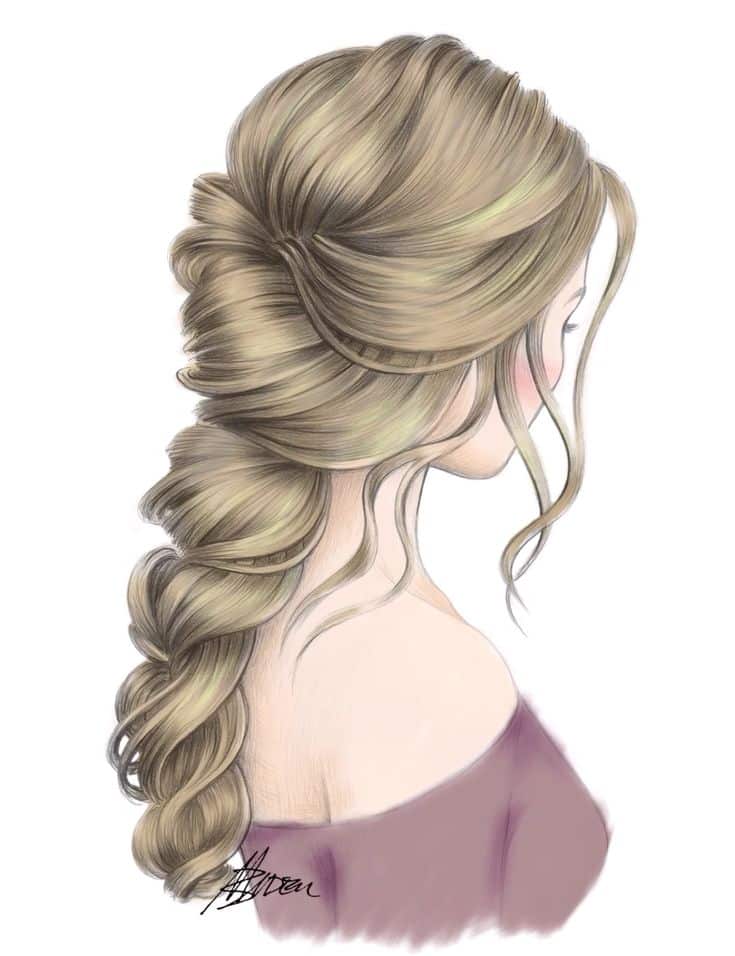
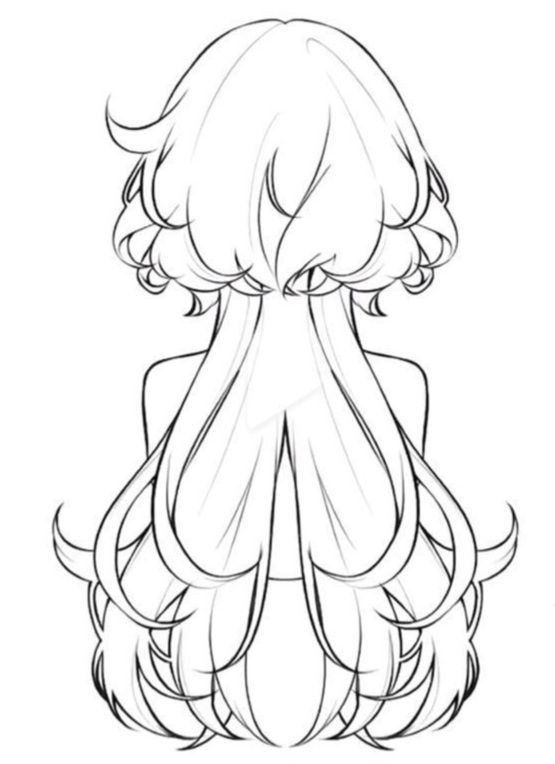
Once you have the overall shape, volume, and movement established, it’s time to bring in the glorious details of texture and individual strands. This is where your ponytail truly starts to shine!
Indicating Texture: Straight, Wavy, Curly
The hair texture dramatically influences how you draw the strands.
- Straight Hair: Characterized by long, smooth, almost parallel lines that fall in relatively unbroken sheets. Focus on subtle, elongated S-curves and crisp highlights. The overall shape will be more streamlined.
- Wavy Hair: Shows more pronounced, gentle undulations. The lines will curve and flow, often separating into distinct waves or “ribbons” of hair. Overlapping wavy clumps are key.
- Curly Hair: Requires drawing individual or grouped spirals and coils. Each curl acts as its own mini-mass, creating a lot of volume and shadow play. Think of spring-like shapes. The key is to show the structure of the curl, not just a squiggly line.
- Coily/Kinky Hair: Often forms tighter, smaller coils or zig-zag patterns. It will have a lot of volume and absorb more light. Depicting these textures means understanding their unique spring-like or zig-zagged structure.
Drawing Individual Strands (Strategically!)
Remember our earlier advice: don’t draw every single strand. Instead, use strategic detailing to suggest texture and realism without overwhelming the drawing.
- Outline and Interior Strands: Use darker, thicker lines for the overall silhouette of the ponytail and major clumps. Then, within these clumps, add a few carefully placed, lighter, thinner lines to represent individual strands. These interior lines help define the direction and flow of the hair.
- Flyaways and Loose Hairs: These are crucial for realism! Add a few wispy, thin lines that break away from the main mass of the ponytail, especially around the tie, the ends, or where the hair is in motion. They add a touch of imperfection that makes hair look natural.
- Highlights and Shadows: Hair is reflective. Use highlights (areas where light hits directly, leaving them unshaded or very lightly shaded) and shadows (areas where hair overlaps or recedes, requiring darker tones) to define the clumps and individual strands. Highlights often appear as streaks running along the direction of the hair flow, reinforcing its texture.
- Tapering Lines: When drawing strands, make your lines taper at the ends. This makes them look more natural and delicate, avoiding blunt, heavy lines that can make hair look stiff.
By carefully integrating texture and judiciously adding strands, you elevate your ponytail from a simple shape to a rich, believable element that enhances your character’s overall appearance.
Types of Ponytails: A Style for Every Character
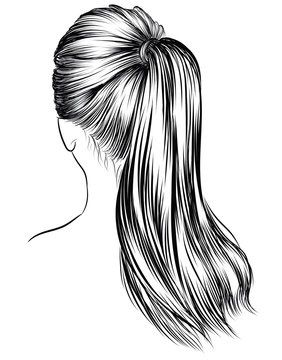
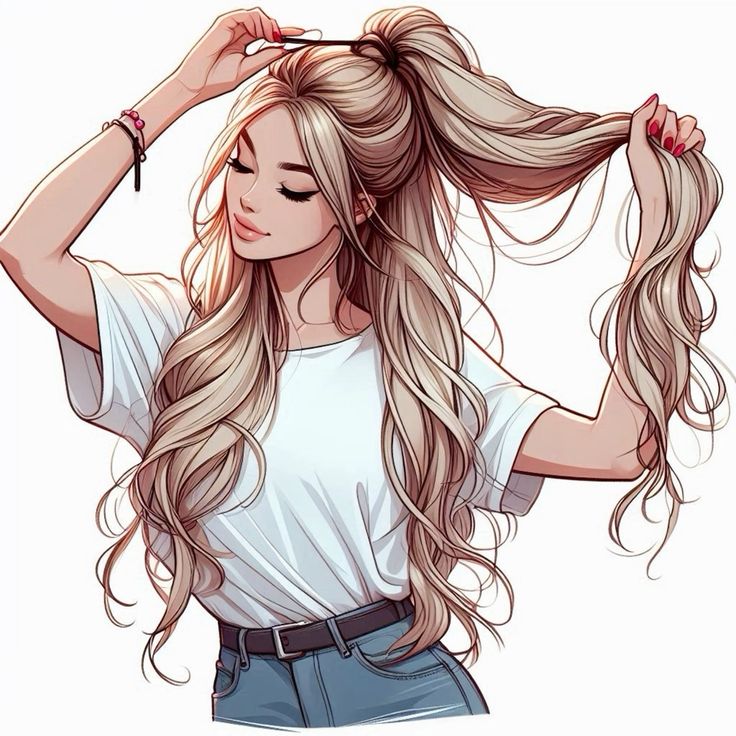
The beauty of the ponytail lies in its incredible versatility! There’s a style to suit every character, mood, and situation. Exploring different types expands your artistic vocabulary and allows you to perfectly match the hairstyle to your character’s personality.
The Classic High Ponytail
- Look: Sits high on the crown, often creating a bouncy, energetic silhouette.
- Character Vibe: Athletic, cheerful, determined, youthful, ready for action.
- Drawing Tips: Emphasize the initial upward lift from the tie before gravity takes over. Great for showing dynamic movement; it swings and bounces a lot.
The Elegant Low Ponytail
- Look: Gathers at the nape of the neck, often sleek and sophisticated.
- Character Vibe: Professional, mature, calm, elegant, thoughtful.
- Drawing Tips: Focus on the smooth transition of hair from the sides of the head down to the tie. Gravity will pull this style downwards more directly, so emphasize clean, gentle curves.
The Playful Side Ponytail
- Look: Gathers at one side of the head, either high or low.
- Character Vibe: Playful, quirky, youthful, artistic, casual.
- Drawing Tips: Show the hair sweeping across the head to one side. Consider the weight distribution and how the hair drapes over the shoulder or chest.
The Messy/Casual Ponytail
- Look: Loose, with plenty of flyaways, bumps, and escaped strands.
- Character Vibe: Relaxed, creative, busy, just-woke-up, approachable.
- Drawing Tips: Embrace imperfection! Don’t worry about perfect lines. Use varying lengths for strands, add subtle bumps around the tie, and let numerous flyaways break the silhouette. This style often has more volume and texture.
Braided Ponytail
- Look: The main body of the ponytail is braided (e.g., a simple three-strand braid, a fishtail, or a French braid).
- Character Vibe: Traditional, neat, intricate, strong, often associated with fantasy or specific cultures.
- Drawing Tips: Learn the basic structure of a braid (overlapping segments). Once the braid structure is drawn, add texture and shading to each segment to show its form. Ensure the braid maintains the overall flow of a ponytail.
Bubble Ponytail
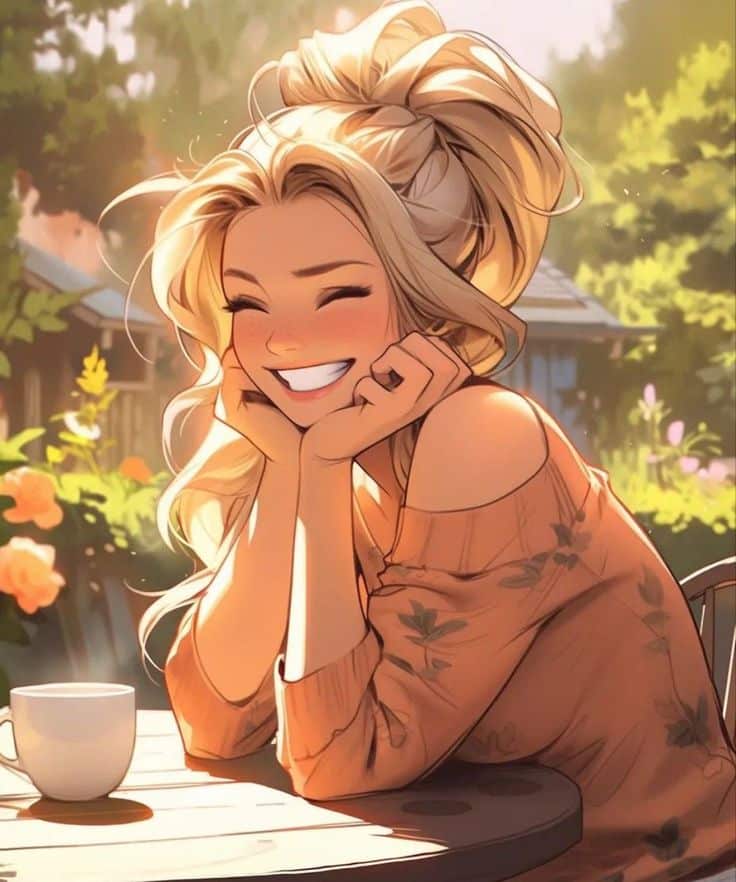
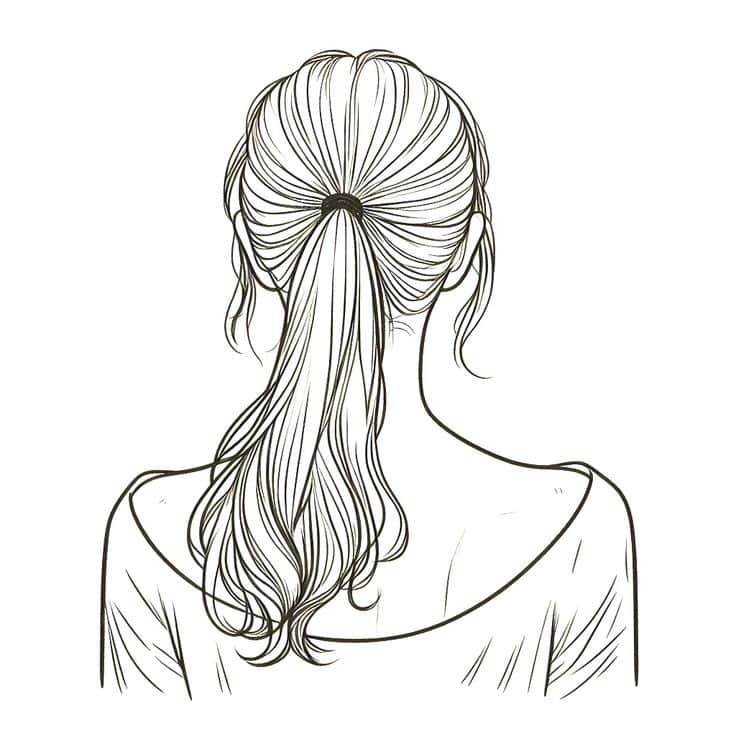
- Look: Hair gathered into sections along its length with multiple ties, creating “bubbles” of hair.
- Character Vibe: Playful, trendy, fashion-forward, whimsical.
- Drawing Tips: Draw distinct, rounded sections of hair separated by visible ties. Each “bubble” should have its own volume and subtle internal curves.
Pigtails (Double Ponytails)
- Look: Two ponytails, usually symmetrical, on either side of the head.
- Character Vibe: Childlike, innocent, energetic, cute, rebellious (depending on style).
- Drawing Tips: Treat each pigtail as an individual ponytail, ensuring they are balanced in terms of volume and flow. Consider how they react in unison to movement.
By experimenting with these different ponytail types, you can add incredible variety and specificity to your character designs. Each style offers unique opportunities for storytelling and aesthetic expression. When sketching characters, consider how a particular ponytail might enhance their fashion sketching for beginners or general base drawing before diving into intricate details.
Expressive Ponytails: Reflecting Mood and Personality
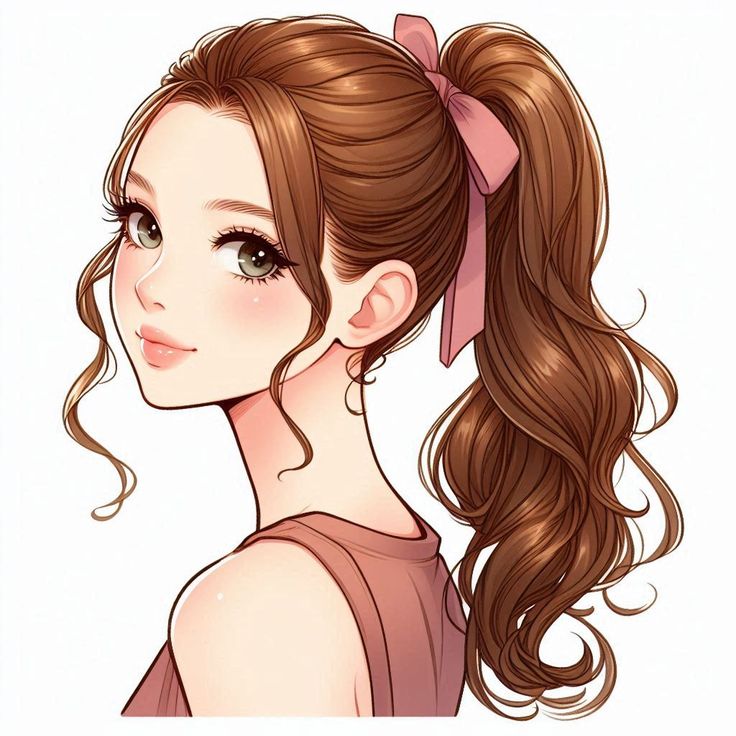
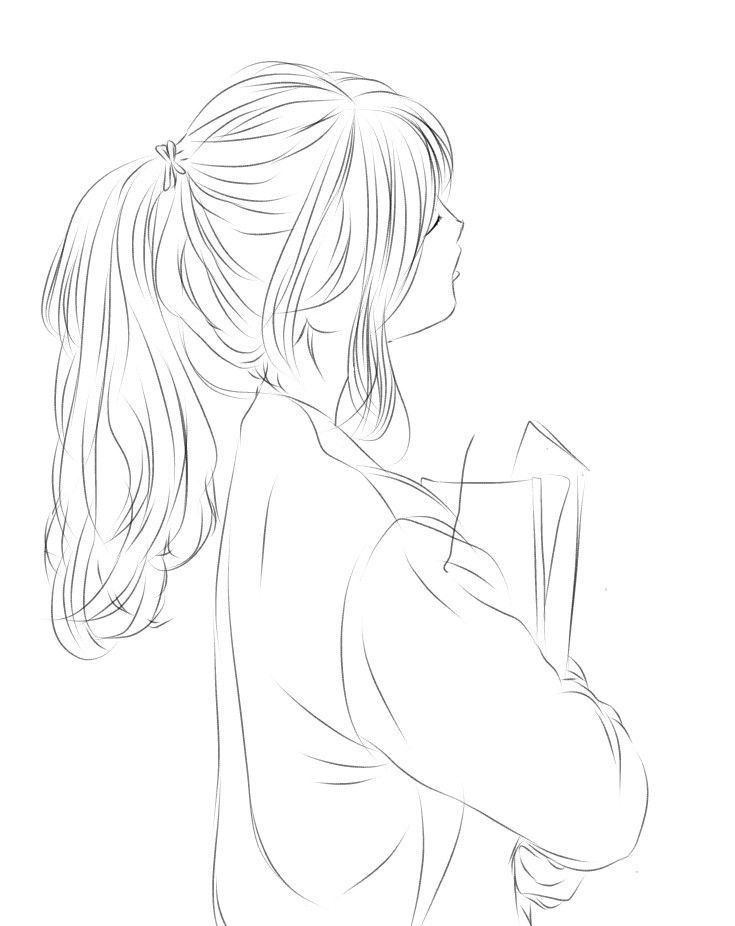
Beyond just looking dynamic, ponytails are fantastic tools for conveying your character’s inner world. The way hair is styled and positioned can subtly (or not-so-subtly) reflect their mood, personality, and even their current situation.
Mood Indicators
- Frustration/Anger: A tightly pulled, almost severe ponytail, perhaps with a few angry flyaways, can communicate determination or irritation. If the character is agitated, the ponytail might appear spiky or slightly disheveled.
- Sadness/Melancholy: A low, loose, perhaps slightly unkempt ponytail, perhaps falling forward over a shoulder or hanging limply, can convey a sense of sadness, exhaustion, or being withdrawn.
- Excitement/Joy: A high, bouncy ponytail, perhaps with a slight upward curve, can radiate enthusiasm and energy. If the character is jumping or laughing, the ponytail will likely be flying freely, adding to the joyous expression.
- Concentration/Seriousness: A neat, contained ponytail, possibly a low one, suggests focus. No distracting strands, everything in its place.
Personality Traits
- Neat and Orderly: A sleek, perfectly groomed ponytail, with not a single hair out of place, speaks volumes about a character who values order, precision, and presentation.
- Rebellious and Free-Spirited: A wild, voluminous, perhaps asymmetrical or extremely messy ponytail screams individuality, defiance, and a carefree attitude.
- Shy and Introverted: A ponytail that partially obscures the face, or a low one that drapes forward, might suggest a character who is reserved, modest, or trying to avoid attention.
- Athletic and Practical: A high, tight ponytail that keeps all hair out of the way is the hallmark of an active, practical individual focused on performance.
Storytelling Through Hair
Think of your character’s ponytail as another limb to express their story.
- A sudden change in a character’s usual ponytail style could signify a major life event, a change in status, or a shift in their emotional state.
- Hair reacting to a scare: If a character is startled, their hair might momentarily “stand on end” or fly outward.
- Hair in a fight: A ponytail can whip dramatically, adding to the visual impact of action sequences.
By deliberately choosing the type, tightness, volume, and movement of your character’s ponytail, you infuse them with an additional layer of non-verbal communication, making your art richer and more compelling. It’s about using every element on the page to tell your story!
Step-by-Step Drawing Process for Any Ponytail
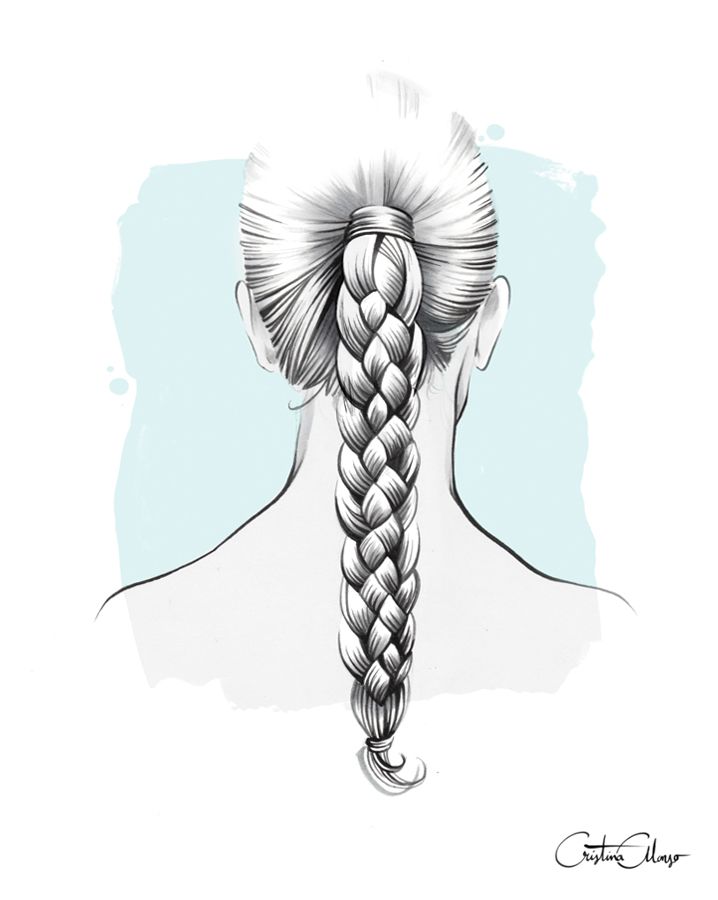
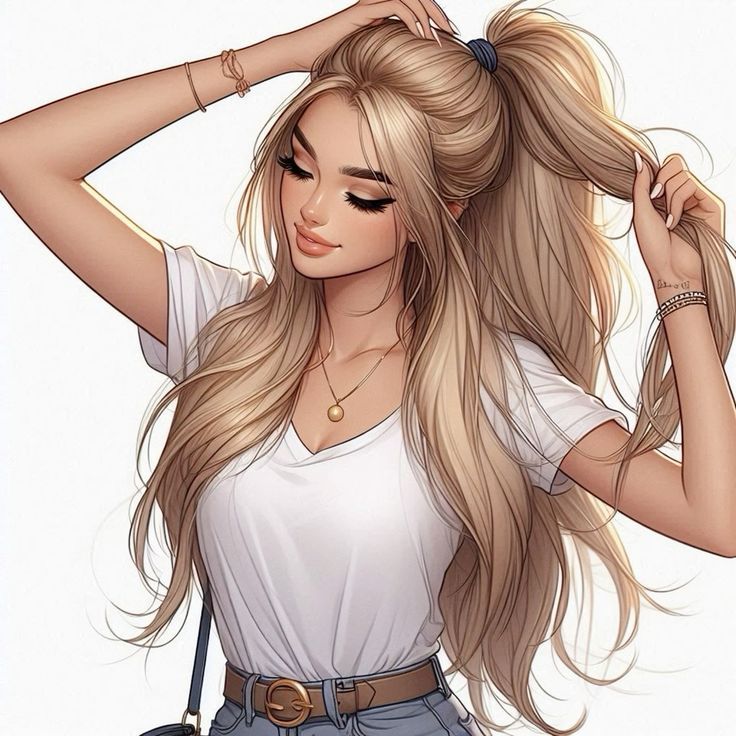
Ready to put it all together? Here’s a general step-by-step process that you can adapt for any ponytail style, whether you’re working on a base drawing or a fully rendered piece.
1. Establish the Head and Hairline
- Draw the Head: Start with a basic head shape (circle/sphere with a jawline).
- Define Hairline: Lightly sketch where the hair begins on the forehead, temples, and nape of the neck. This helps ground the hair to the skull.
2. Place the Ponytail Tie and Initial Direction
- Mark the Tie Spot: Decide where the ponytail will be anchored (high, low, side). Lightly mark this spot.
- Draw a Rough “Stem”: From the tie spot, draw a short, curved line indicating the initial direction the ponytail will spring from the head. This helps with the initial lift.
3. Block Out the Main Hair Mass
- Overall Silhouette: Using loose, flowing lines, sketch the large, overarching shape of the entire ponytail. Don’t worry about details yet. Think about its volume, length, and how it flows away from the head, influenced by gravity or motion. Is it a long, flowing arc, or a shorter, bouncier shape?
- Hair Leading to the Tie: Sketch the hair on the sides and top of the head that is being pulled back towards the tie. Use gentle curves to show it lifting from the scalp.
4. Define Major Hair Clumps
- Divide the Mass: Within the large silhouette, start to break the ponytail down into 3-5 major, overlapping clumps or sections. Use soft, curved lines to define these.
- Show Overlap: Ensure these clumps overlap each other to create depth and volume. Imagine them as 3D forms, not flat shapes.
5. Add Flow and Internal Lines
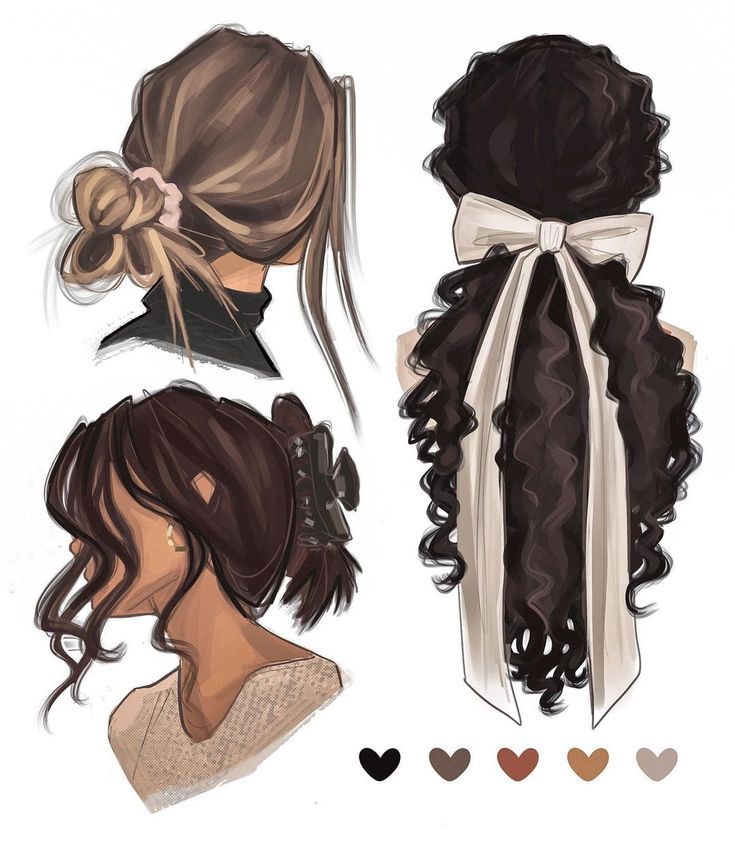
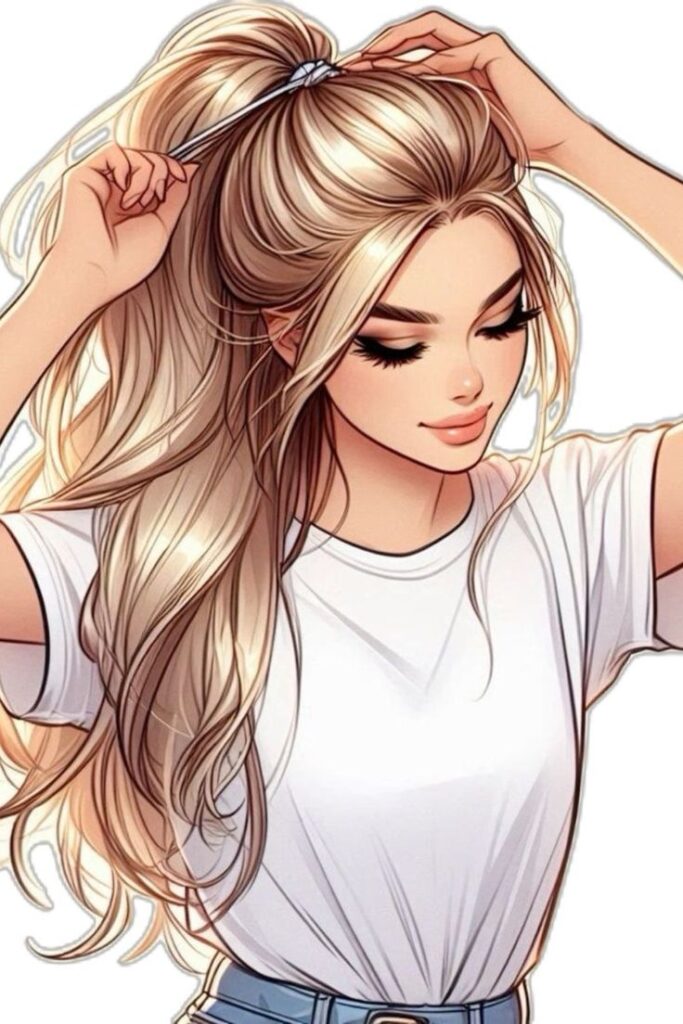
- Directional Flow: Within each major clump, draw lighter, curved lines that follow the overall direction of the hair. These lines help reinforce the S-curve principle and show where the hair is moving.
- Texture Hint: If the hair is curly, start hinting at the curl patterns here. If it’s wavy, show those gentle undulations.
6. Introduce Details: Strands, Flyaways, and Tie
- Individual Strands (Sparingly!): Along the edges of the ponytail and within some clumps, add a few thin, tapering lines to suggest individual strands. Focus these where light would hit or where separation is most obvious.
- Flyaways: Add wispy, delicate lines around the hairline, temples, and the main body of the ponytail to make it look more natural and less stiff.
- Draw the Tie: Carefully render the hair tie or accessory, showing how it cinches the hair. If the hair is wrapped, show the overlapping hair.
7. Refine with Light and Shadow (Shading)
- Highlight Placement: Identify your light source. Where does the light hit the ponytail directly? These areas will be the brightest.
- Shadow Mapping: Shade the areas where hair recedes, overlaps, or is furthest from the light source. This is crucial for giving the ponytail true three-dimensionality.
- Contrast: Use varying degrees of darkness to create contrast, making the hair pop and look shiny or soft.
8. Final Polish
- Clean Up Lines: Erase any unnecessary sketch lines.
- Strengthen Important Lines: Darken and sharpen key outlines and flow lines to give the ponytail definition.
- Add Finishing Touches: Any stray details, reflections, or very subtle color variations.
By following this methodical approach, you can systematically build a convincing and dynamic ponytail, transforming your initial rough sketch into a polished work of art! And if you’re ever stuck for general drawing inspiration or want to explore new subjects, remember there are always fantastic art drawing ideas to spark your creativity!
Practice and Observation: The True Path to Mastery
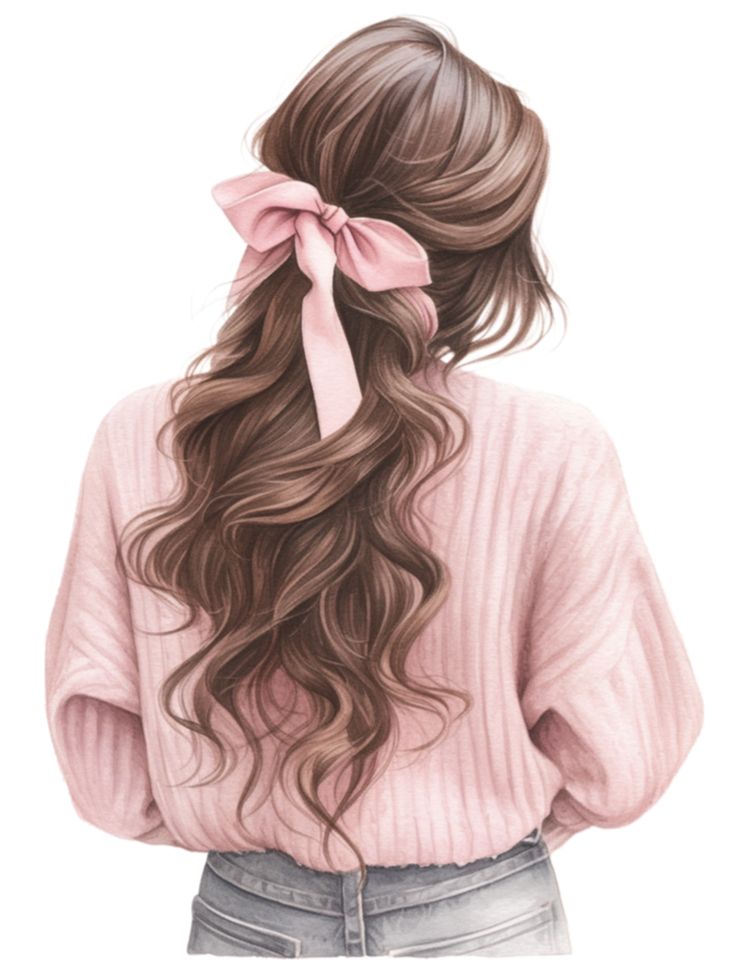
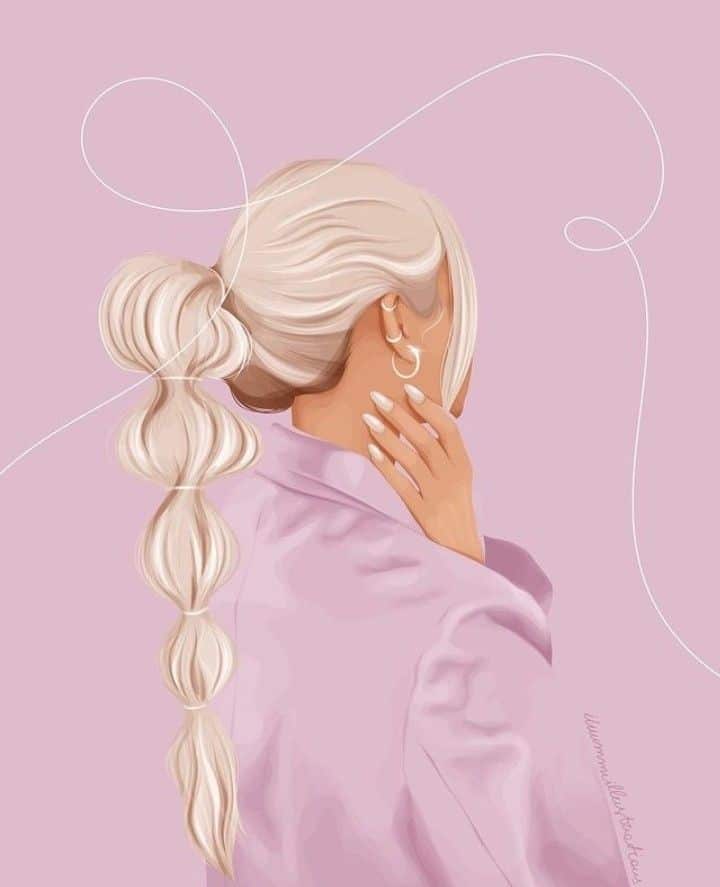
Congratulations, you’ve absorbed a ton of knowledge about drawing awesome ponytails! But here’s the absolute truth: knowledge without practice is just information. The real magic happens when you put pencil to paper (or stylus to screen) and do the work.
The Power of Consistent Practice
- Daily Doodles: Even 15-30 minutes a day dedicated to drawing ponytails (or hair in general) will yield incredible results over time. Consistency beats sporadic long sessions.
- Focused Sessions: Instead of just aimless doodling, set specific goals. “Today I’ll draw 10 high ponytails in motion.” “Tomorrow I’ll focus on curly ponytails.”
- Copy to Learn: Don’t be afraid to copy other artists’ work for practice only. Analyze how they achieve volume, flow, and texture. This is a learning tool, not for claiming as your own.
- Self-Critique: After each drawing, ask yourself: Does it have volume? Does gravity make sense? Is the movement convincing? What could be better next time?
The Art of Observation
The world around you is your best art teacher.
- Study Real Hair: Pay attention to people’s ponytails in real life, in movies, magazines, and photos. How does light hit it? How does it move when they walk, turn, or talk? What happens to the hair near the tie?
- Use References: Gather a strong library of reference photos for different hair types, lengths, and ponytail styles. Don’t rely solely on memory; real-world references provide crucial details you might otherwise miss.
- Hair in Different Conditions: Observe hair wet vs. dry, in calm weather vs. windy conditions, clean vs. messy. Each scenario will present unique challenges and opportunities for realism.
- Beyond Ponytails: Understanding how all hair behaves will improve your ponytail drawing. Study braids, buns, loose hair, short hair.
Remember, every stroke you make is a lesson learned. Every attempt, even the “failed” ones, brings you closer to mastery. Embrace the process, have fun, and keep drawing! With dedication and keen observation, you’ll soon be rocking truly awesome ponytails in all your artistic endeavors.
Your Ponytail Power-Up!
Wow, what an exhilarating journey we’ve had, diving deep into the art of drawing truly spectacular ponytails! From understanding the fundamental principles of hair to deconstructing the ponytail into its core components, exploring diverse styles, and mastering dynamic movement, you’ve gained an arsenal of knowledge to elevate your artistic game.
We’ve covered the essential interplay of flow and gravity, the magic of volume and weight, and the importance of texture and strategic strand detailing. We’ve discovered how different ponytail types can inject personality into your characters and learned to avoid common pitfalls that can make hair look stiff or unnatural. Most importantly, we’ve emphasized that ponytails are not just hair; they are powerful narrative tools, capable of conveying mood, action, and character with incredible impact.
So, what’s next for you? It’s time to unleash that newfound creativity! Grab your favorite drawing tools, load up your digital canvas, and start experimenting. Don’t be afraid to make mistakes—they are invaluable learning opportunities. Observe the world around you, gather references, and most importantly, practice, practice, practice!
Your characters are waiting for their perfect, expressive ponytails. Go forth and create art that truly rocks!
- 510shares
- Facebook0
- Pinterest510
- Twitter0
